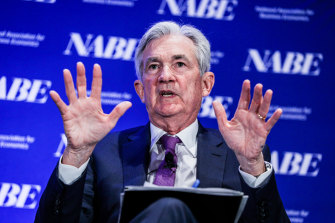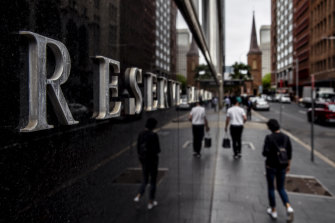The Fed and RBA have finally hit ‘lift-off’ but may have waited too long

The US Federal Reserve has finally, and belatedly, accepted what most in and around financial markets recognised quite some time ago: US inflation is raging out of control and far more decisive efforts to stamp it out are required.
After its half-hearted 25 basis point increase to the federal funds rate in March – after two years where the rate was effectively zero – the Fed has announced its first 50 basis point rise in 22 years in response to an inflation rate of 8.5 per cent, the highest in 40 years.
Led by Jerome Powell, the Fed is desperate to try and engineer a “soft landing” for the US. Credit:Bloomberg
It’s also announced plans to start shrinking its near-$US9 trillion ($12.4 trillion) balance sheet, a balance sheet swollen by the near-$US5 trillion purchases of bonds and mortgage securities it has made since the onset of the pandemic.
For the next three months it will allow $US47.5 billion a month of those securities to run off as they mature without reinvesting the proceeds. From September the rate of “quantitative tightening” will increase to $US95 billion a month, withdrawing liquidity from the US – and global – financial system.
The Fed’s announcements disappointed the more “hawkish” analysts, who had been calling for a 75 basis point increase in the policy rate to provide a bigger statement of the Fed’s intent but was greeted with relieved delight by financial markets that had feared a 75 basis point rise.
The US sharemarket, which has taken a battering so far this year, rose almost 3 per cent and bond yields edged down as the Fed chairman, Jerome Powell, also talked down the prospect of 75 basis point moves in future as something the Fed is not actively considering while also saying that more 50 basis point moves are “on the table” at the next few Fed Open Market Committee meetings.
The markets are pricing in at least five more rate increases this year and a federal funds rate that tops out above 3 per cent, if not higher. The equity investor enthusiasm of Wednesday might be short-lived.
The Fed, like the Reserve Bank, was slow to accept that the forces that increasingly fuelled global inflation rates through last year weren’t as “transient” as they had anticipated.
The supply chain disruptions generated by the pandemic, which coincided with an unexpected surge in consumer demand, haven’t been resolved and some elements of the response to the pandemic, like reshoring of critical industries, will have long-term structural impacts on prices.
Indeed, a fresh bout of disruption is occurring as China grapples with continuing outbreaks of newer variants of the coronavirus. Its “zero COVID” approach to the outbreaks in some of its biggest and most economically significant cities – severe and quite brutal lockdowns – and the chilling effect that has had on transports of goods and intermediate products and materials within China is continuing to roil global supply chains.
That will continue to feed into global inflation rates, as will the war in Ukraine and its impact on global energy prices. Those issues are beyond central bankers’ control or influence.
The question confronting the Fed, as it does the RBA, is whether – having accepted their own tardiness – they are now responding decisively enough to start to bring inflation under control.Credit:Louie Douvis
The question confronting the Fed, as it does the RBA, is whether – having accepted their own tardiness – they are now responding decisively enough to start to bring inflation under control.
In both economies unemployment is at historically low levels, household savings are at historical highs and business profitability is strong, thanks to the massive fiscal responses to the pandemic.
Inflation is being demand-driven and exacerbated by the supply shortages and increased costs of supply.
The challenge for both the central banks, and their peers elsewhere, is to engineer a “soft” landing for their economies rather than being forced by a continuing inflationary spiral into driving the economies into recession. Powell, after the release of the Fed’s decisions, said that, while it wouldn’t be easy, he thought the US had a good chance of a “soft or softish” landing.
If the US, or Australia, can escape the high inflation trap without a recession it will require good monetary policy-making by the central banks, and a large dose of good luck, given the uncertainty surrounding the economic outlooks for China and, because of the war in Ukraine and soaring energy costs and disrupted supply, Europe.
The question confronting the Fed, as it does the RBA, is whether – having accepted their own tardiness – they are now responding decisively enough to start to bring inflation under control.
The rising tide of central bank interest rates in developed economies has implications for sharemarkets, which still have stretched valuations by historical standards, despite the significant sell-off this year – even after Wednesday’s surge the US market is still down about 10 per cent this year — and for bond markets.
The bull market in bonds that dates back to the early 1980s has been under threat for some time but was saved by the pandemic and the flight to safety and flood of central bank-created money it induced.
Any acceleration in the tightening of US monetary policy beyond the rate rises and the measured pace of quantitative tightening Powell has foreshadowed would threaten a recession – and share and bond prices.
Past breakouts of inflation have generally forced central banks to engineer recessions by raising rates to the point where economic activity slows and unemployment rises.
Under Paul Volker the Fed drove the federal funds rate up to 20 per cent in the early 1980s to bring inflation under control, causing a deep recession in the process. Paul Keating’s “recession we had to have” saw the cash rate peak at 17.5 per cent in 1990 under RBA governor, Bernie Fraser.
Hopefully there is some transience within the influences behind the current breakouts of inflation that enables a “softish” landing. The alternative would be unpleasant, at best, as anyone who lived through the recession in Australia in the early 1990s could attest.
The Business Briefing newsletter delivers major stories, exclusive coverage and expert opinion. Sign up to get it every weekday morning.
Most Viewed in Business
From our partners
Source: Read Full Article


